battery replacement NISSAN MAXIMA 2023 Owners Manual
[x] Cancel search | Manufacturer: NISSAN, Model Year: 2023, Model line: MAXIMA, Model: NISSAN MAXIMA 2023Pages: 494, PDF Size: 5.7 MB
Page 112 of 494

VEHICLE INFORMATION DISPLAY
WARNINGS AND INDICATORS
The following messages may appear in
your vehicle information display.
Engine start operation for
Intelligent Key system
(if I-Key battery level is low)
This indicator appears when the battery of
the Intelligent Key is low and when the In-
telligent Key system and the vehicle are not
communicating normally.
If this appears, touch the ignition switch
with the Intelligent Key while depressing
the brake pedal. For additional information,
see “NISSAN Intelligent Key® battery dis-
charge” (P. 5-13).
Key Battery Low
This indicator appears when the Intelligent
Key battery is running out of power.
If this indicator appears, replace the bat-
tery with a new one. For additional infor-
mation, see “Battery replacement” (P. 8-22).
Key ID Incorrect
This warning appears when the ignition
switch is placed from the OFF position and
the Intelligent Key is not recognized by the
system. You cannot start the engine with
an unregistered key.
For additional information, see “NISSAN In-
telligent Key®” (P. 3-2).
Key System Fault See
Owner’s Manual
Af ter the ignition switch is placed in the ON
position, this warning appears for a period
of time and then turns off.
The Key System Fault message warns of a
malfunction with the Intelligent Key sys-
tem. If the warning appears while the en-
gine is stopped, it may be impossible to
start the engine.
If the warning appears while the engine is
running, you can drive the vehicle. However,
in these cases, have the system checked. It
is recommended that you visit a NISSAN
dealer for this service.
No Key Detected
This warning appears when the Intelligent
Key is lef t outside the vehicle with the igni-
tion switch in the ON position. Make sure
the Intelligent Key is inside the vehicle.
For additional information, see “NISSAN In-
telligent Key®” (P. 3-2).
Alarm - Time for a break?
This indicator appears when the driver en-
ables the Timer Alert function within the
Driving Aids settings and the selected set
time is expired. The time is based on igni-
tion on time and can be set up to six hours.
Brightness indicator
This indicator shows the brightness ad-
justment of the instrument panel. For addi-
tional information, see “Instrument bright-
ness control” (P. 2-52).
Rear Door Alert is activated
When the system is enabled, this message
appears when the Rear Door Alert system
is active and can remind the driver to check
the rear seat.
2-26Instruments and controls
Page 182 of 494
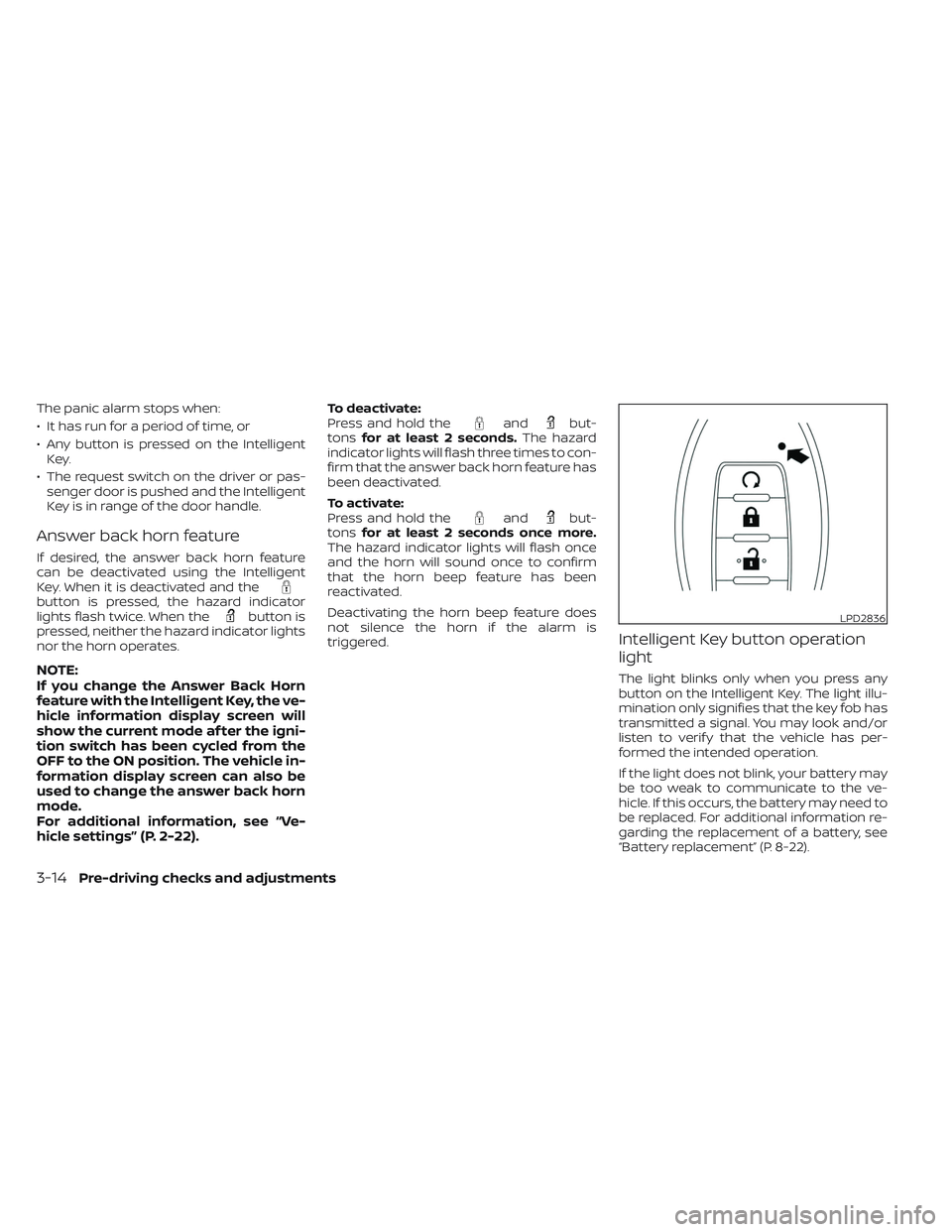
The panic alarm stops when:
• It has run for a period of time, or
• Any button is pressed on the IntelligentKey.
• The request switch on the driver or pas- senger door is pushed and the Intelligent
Key is in range of the door handle.
Answer back horn feature
If desired, the answer back horn feature
can be deactivated using the Intelligent
Key. When it is deactivated and the
button is pressed, the hazard indicator
lights flash twice. When thebutton is
pressed, neither the hazard indicator lights
nor the horn operates.
NOTE:
If you change the Answer Back Horn
feature with the Intelligent Key, the ve-
hicle information display screen will
show the current mode af ter the igni-
tion switch has been cycled from the
OFF to the ON position. The vehicle in-
formation display screen can also be
used to change the answer back horn
mode.
For additional information, see “Ve-
hicle settings” (P. 2-22).
To deactivate:
Press and hold theandbut-
tons for at least 2 seconds. The hazard
indicator lights will flash three times to con-
firm that the answer back horn feature has
been deactivated.
To activate:
Press and hold the
andbut-
tons for at least 2 seconds once more.
The hazard indicator lights will flash once
and the horn will sound once to confirm
that the horn beep feature has been
reactivated.
Deactivating the horn beep feature does
not silence the horn if the alarm is
triggered.
Intelligent Key button operation
light
The light blinks only when you press any
button on the Intelligent Key. The light illu-
mination only signifies that the key fob has
transmitted a signal. You may look and/or
listen to verif y that the vehicle has per-
formed the intended operation.
If the light does not blink, your battery may
be too weak to communicate to the ve-
hicle. If this occurs, the battery may need to
be replaced. For additional information re-
garding the replacement of a battery, see
“Battery replacement” (P. 8-22).
LPD2836
3-14Pre-driving checks and adjustments
Page 184 of 494
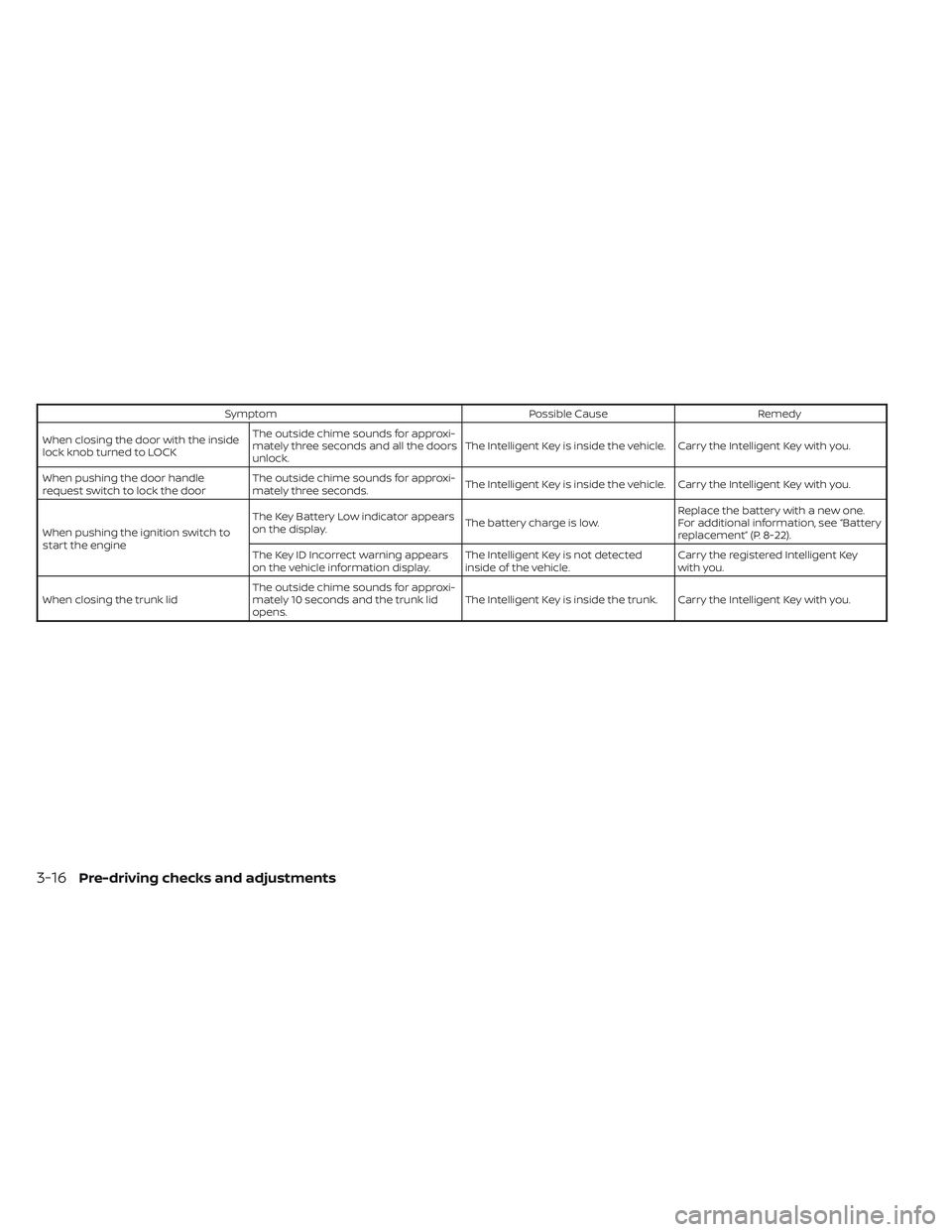
SymptomPossible CauseRemedy
When closing the door with the inside
lock knob turned to LOCK The outside chime sounds for approxi-
mately three seconds and all the doors
unlock.
The Intelligent Key is inside the vehicle. Carry the Intelligent Key with you.
When pushing the door handle
request switch to lock the door The outside chime sounds for approxi-
mately three seconds.
The Intelligent Key is inside the vehicle. Carry the Intelligent Key with you.
When pushing the ignition switch to
start the engine The Key Battery Low indicator appears
on the display.
The battery charge is low.Replace the battery with a new one.
For additional information, see “Battery
replacement” (P. 8-22).
The Key ID Incorrect warning appears
on the vehicle information display. The Intelligent Key is not detected
inside of the vehicle.Carry the registered Intelligent Key
with you.
When closing the trunk lid The outside chime sounds for approxi-
mately 10 seconds and the trunk lid
opens. The Intelligent Key is inside the trunk. Carry the Intelligent Key with you.
3-16Pre-driving checks and adjustments
Page 247 of 494
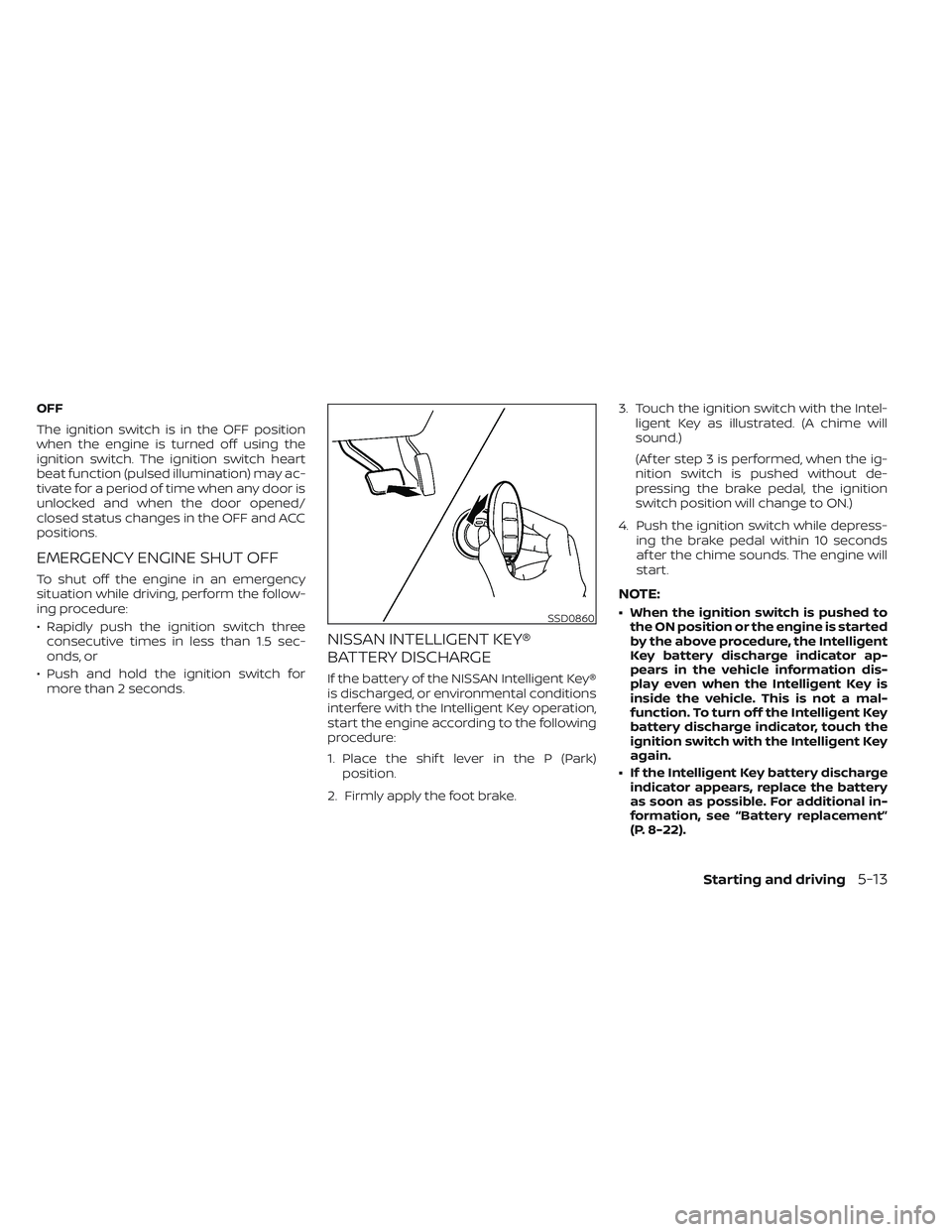
OFF
The ignition switch is in the OFF position
when the engine is turned off using the
ignition switch. The ignition switch heart
beat function (pulsed illumination) may ac-
tivate for a period of time when any door is
unlocked and when the door opened/
closed status changes in the OFF and ACC
positions.
EMERGENCY ENGINE SHUT OFF
To shut off the engine in an emergency
situation while driving, perform the follow-
ing procedure:
• Rapidly push the ignition switch threeconsecutive times in less than 1.5 sec-
onds, or
• Push and hold the ignition switch for more than 2 seconds.
NISSAN INTELLIGENT KEY®
BATTERY DISCHARGE
If the battery of the NISSAN Intelligent Key®
is discharged, or environmental conditions
interfere with the Intelligent Key operation,
start the engine according to the following
procedure:
1. Place the shif t lever in the P (Park) position.
2. Firmly apply the foot brake. 3. Touch the ignition switch with the Intel-
ligent Key as illustrated. (A chime will
sound.)
(Af ter step 3 is performed, when the ig-
nition switch is pushed without de-
pressing the brake pedal, the ignition
switch position will change to ON.)
4. Push the ignition switch while depress- ing the brake pedal within 10 seconds
af ter the chime sounds. The engine will
start.
NOTE:
• When the ignition switch is pushed tothe ON position or the engine is started
by the above procedure, the Intelligent
Key battery discharge indicator ap-
pears in the vehicle information dis-
play even when the Intelligent Key is
inside the vehicle. This is not a mal-
function. To turn off the Intelligent Key
battery discharge indicator, touch the
ignition switch with the Intelligent Key
again.
• If the Intelligent Key battery discharge indicator appears, replace the battery
as soon as possible. For additional in-
formation, see “Battery replacement”
(P. 8-22).SSD0860
Starting and driving5-13
Page 385 of 494
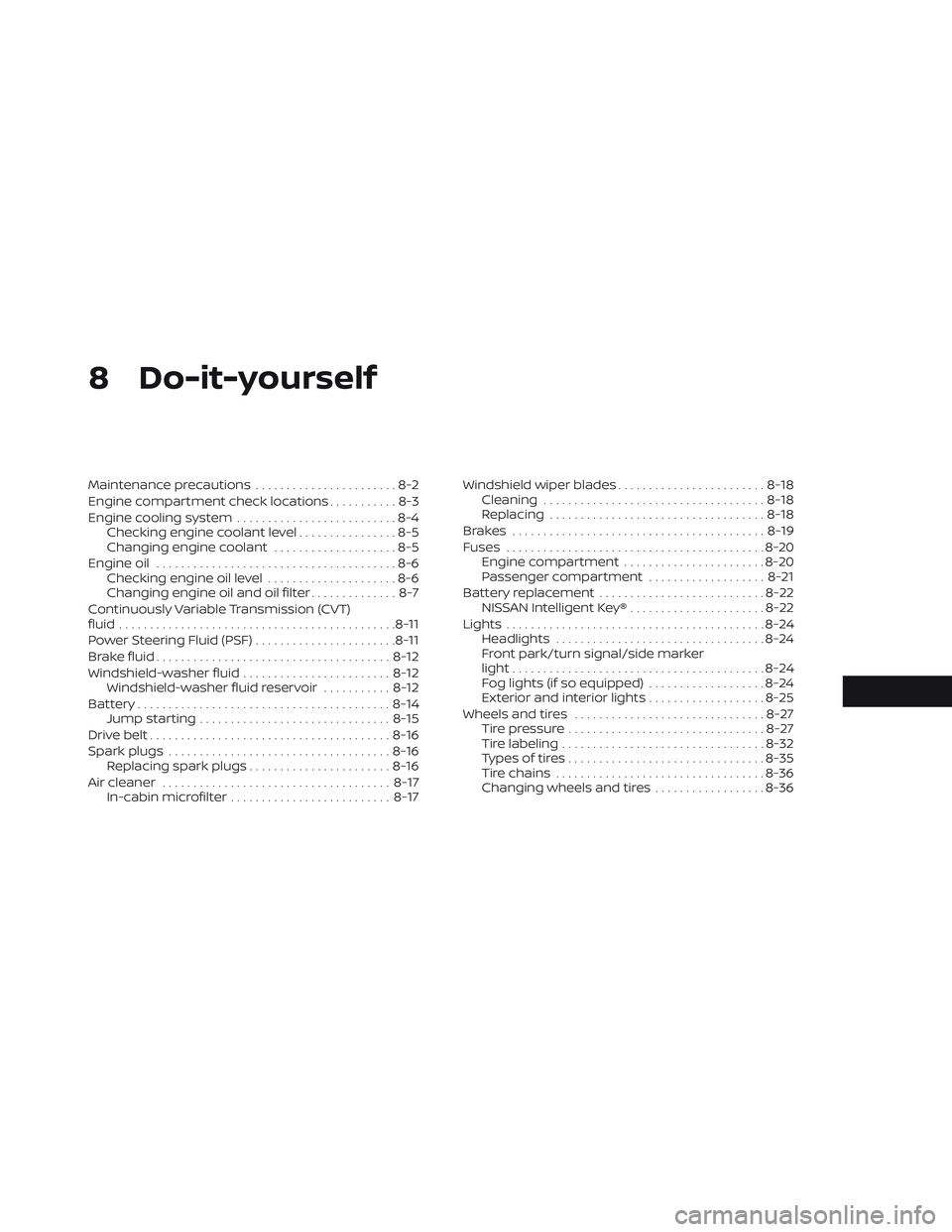
8 Do-it-yourself
Maintenance precautions.......................8-2
Engine compartment check locations ...........8-3
Engine cooling system ..........................8-4
Checking engine coolant level ................8-5
Changing engine coolant ....................8-5
Engine oil .......................................8-6
Checking engine oil level .....................8-6
Changing engine oil and oil filter ..............8-7
Continuously Variable Transmission (CVT)
fluid ............................................. 8-11
Power Steering Fluid (PSF) .......................8-11
Brake fluid ...................................... 8-12
Windshield-washer fluid ........................8-12
Windshield-washer fluid reservoir ...........8-12
Battery......................................... 8-14
Jump starting ............................... 8-15
Drive belt ....................................... 8-16
Spark plugs .................................... 8-16
Replacing spark plugs .......................8-16
Air cleaner ..................................... 8-17
In-cabin microfilter .......................... 8-17Windshield wiper blades
........................8-18
Cleaning .................................... 8-18
Replacing ................................... 8-18
Brakes ......................................... 8-19
Fuses .......................................... 8-20
Engine compartment .......................8-20
Passenger compartment ...................8-21
Battery replacement ........................... 8-22
NISSAN Intelligent Key® ......................8-22
Lights .......................................... 8-24
Headlights .................................. 8-24
Front park/turn signal/side marker
light ......................................... 8-24
Fog lights (if so equipped) ...................8-24
Exterior and interior lights ...................8-25
Wheels and tires ............................... 8-27
Tire pressure ................................ 8-27
Tire labeling .................................
8-32
T
ypes of tires ................................ 8-35
Tire chains .................................. 8-36
Changing wheels and tires ..................8-36
Page 386 of 494
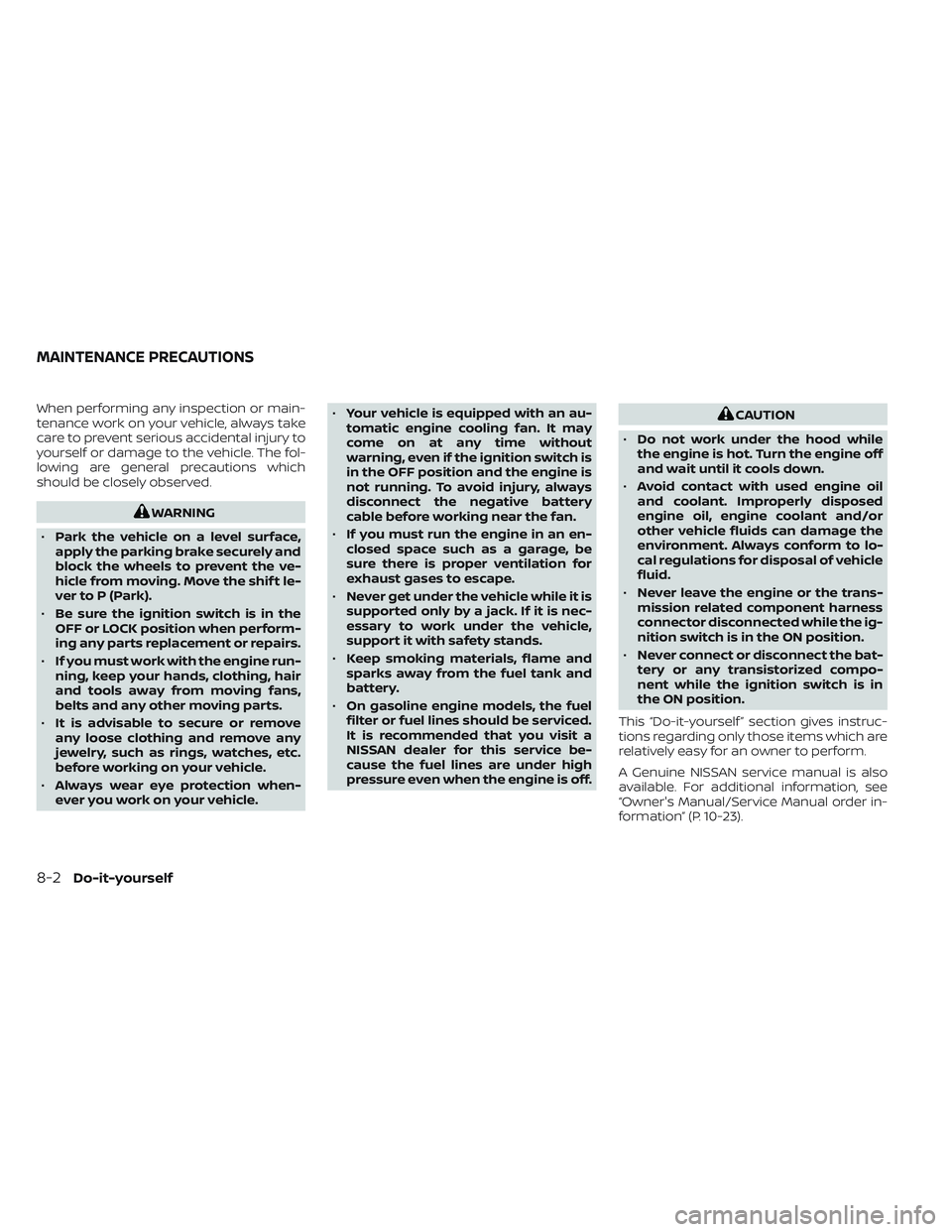
When performing any inspection or main-
tenance work on your vehicle, always take
care to prevent serious accidental injury to
yourself or damage to the vehicle. The fol-
lowing are general precautions which
should be closely observed.
WARNING
• Park the vehicle on a level surface,
apply the parking brake securely and
block the wheels to prevent the ve-
hicle from moving. Move the shif t le-
ver to P (Park).
• Be sure the ignition switch is in the
OFF or LOCK position when perform-
ing any parts replacement or repairs.
• If you must work with the engine run-
ning, keep your hands, clothing, hair
and tools away from moving fans,
belts and any other moving parts.
• It is advisable to secure or remove
any loose clothing and remove any
jewelry, such as rings, watches, etc.
before working on your vehicle.
• Always wear eye protection when-
ever you work on your vehicle. •
Your vehicle is equipped with an au-
tomatic engine cooling fan. It may
come on at any time without
warning, even if the ignition switch is
in the OFF position and the engine is
not running. To avoid injury, always
disconnect the negative battery
cable before working near the fan.
• If you must run the engine in an en-
closed space such as a garage, be
sure there is proper ventilation for
exhaust gases to escape.
• Never get under the vehicle while it is
supported only by a jack. If it is nec-
essary to work under the vehicle,
support it with safety stands.
• Keep smoking materials, flame and
sparks away from the fuel tank and
battery.
• On gasoline engine models, the fuel
filter or fuel lines should be serviced.
It is recommended that you visit a
NISSAN dealer for this service be-
cause the fuel lines are under high
pressure even when the engine is off.
CAUTION
• Do not work under the hood while
the engine is hot. Turn the engine off
and wait until it cools down.
• Avoid contact with used engine oil
and coolant. Improperly disposed
engine oil, engine coolant and/or
other vehicle fluids can damage the
environment. Always conform to lo-
cal regulations for disposal of vehicle
fluid.
• Never leave the engine or the trans-
mission related component harness
connector disconnected while the ig-
nition switch is in the ON position.
• Never connect or disconnect the bat-
tery or any transistorized compo-
nent while the ignition switch is in
the ON position.
This “Do-it-yourself ” section gives instruc-
tions regarding only those items which are
relatively easy for an owner to perform.
A Genuine NISSAN service manual is also
available. For additional information, see
“Owner's Manual/Service Manual order in-
formation” (P. 10-23).
MAINTENANCE PRECAUTIONS
8-2Do-it-yourself
Page 406 of 494
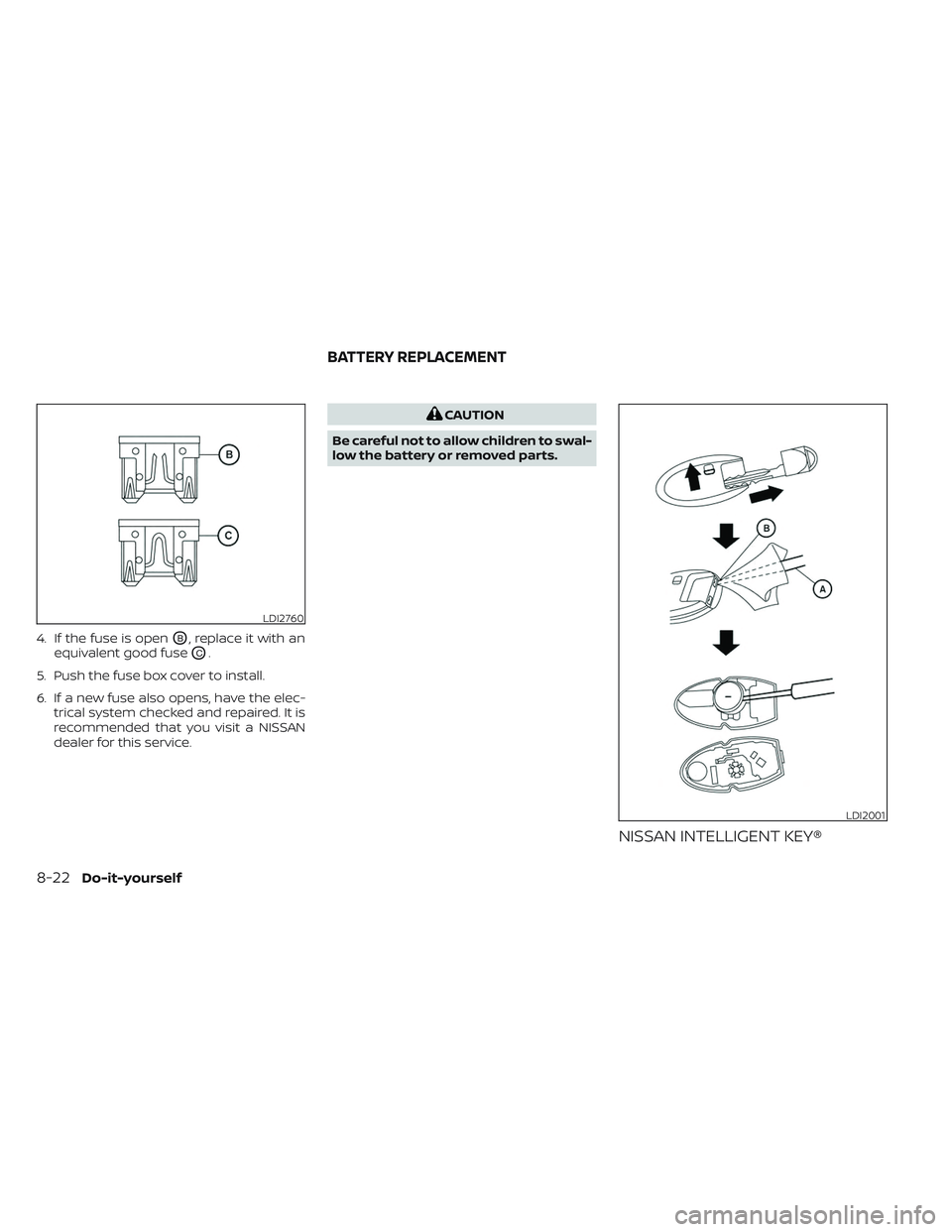
4. If the fuse is openOB, replace it with an
equivalent good fuse
OC.
5. Push the fuse box cover to install.
6. If a new fuse also opens, have the elec- trical system checked and repaired. It is
recommended that you visit a NISSAN
dealer for this service.
CAUTION
Be careful not to allow children to swal-
low the battery or removed parts.
NISSAN INTELLIGENT KEY®
LDI2760
LDI2001
BATTERY REPLACEMENT
8-22Do-it-yourself
Page 448 of 494
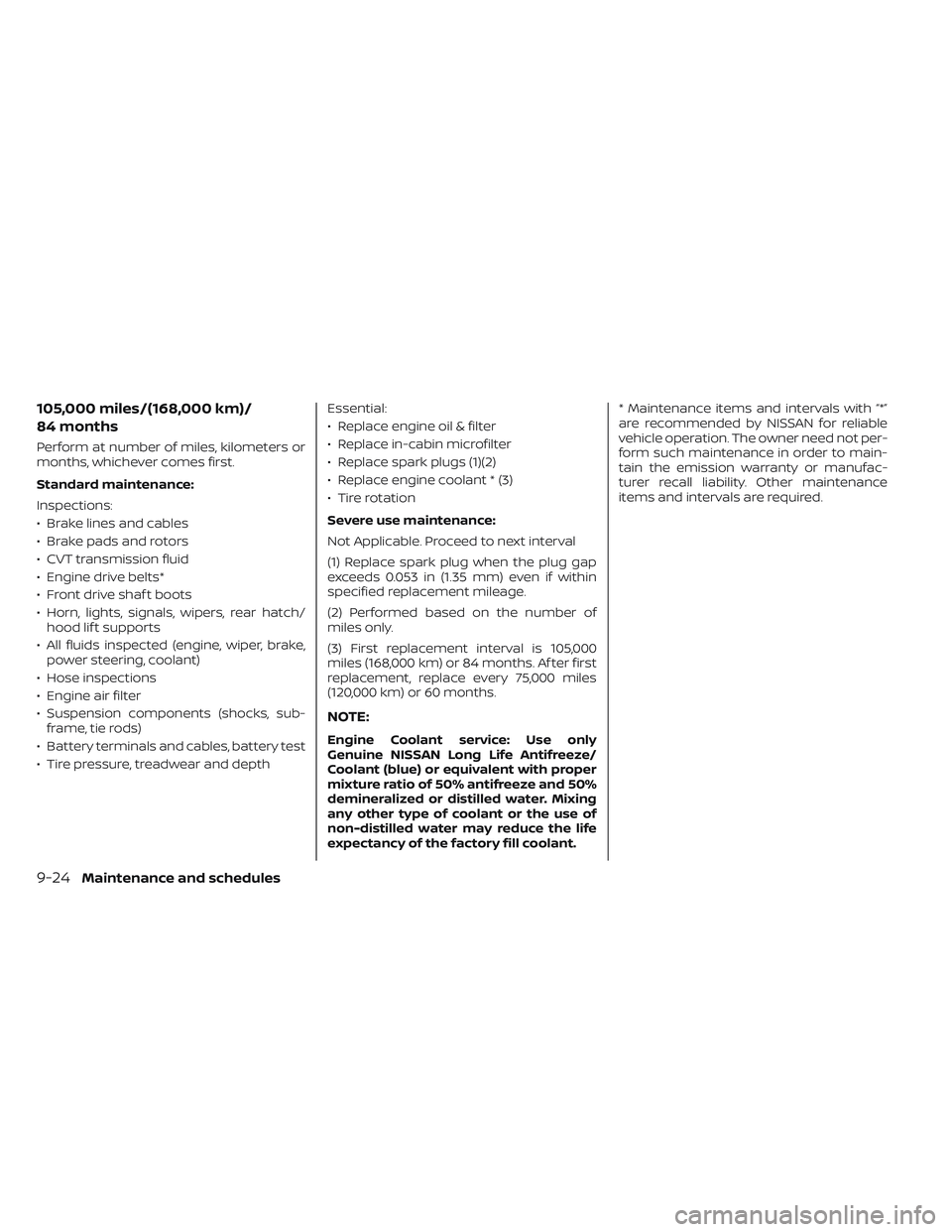
105,000 miles/(168,000 km)/
84 months
Perform at number of miles, kilometers or
months, whichever comes first.
Standard maintenance:
Inspections:
• Brake lines and cables
• Brake pads and rotors
• CVT transmission fluid
• Engine drive belts*
• Front drive shaf t boots
• Horn, lights, signals, wipers, rear hatch/hood lif t supports
• All fluids inspected (engine, wiper, brake, power steering, coolant)
• Hose inspections
• Engine air filter
• Suspension components (shocks, sub- frame, tie rods)
• Battery terminals and cables, battery test
• Tire pressure, treadwear and depth Essential:
• Replace engine oil & filter
• Replace in-cabin microfilter
• Replace spark plugs (1)(2)
• Replace engine coolant * (3)
• Tire rotation
Severe use maintenance:
Not Applicable. Proceed to next interval
(1) Replace spark plug when the plug gap
exceeds 0.053 in (1.35 mm) even if within
specified replacement mileage.
(2) Performed based on the number of
miles only.
(3) First replacement interval is 105,000
miles (168,000 km) or 84 months. Af ter first
replacement, replace every 75,000 miles
(120,000 km) or 60 months.
NOTE:
Engine Coolant service: Use only
Genuine NISSAN Long Life Antifreeze/
Coolant (blue) or equivalent with proper
mixture ratio of 50% antifreeze and 50%
demineralized or distilled water. Mixing
any other type of coolant or the use of
non-distilled water may reduce the life
expectancy of the factory fill coolant.* Maintenance items and intervals with “*”
are recommended by NISSAN for reliable
vehicle operation. The owner need not per-
form such maintenance in order to main-
tain the emission warranty or manufac-
turer recall liability. Other maintenance
items and intervals are required.
9-24Maintenance and schedules
Page 477 of 494
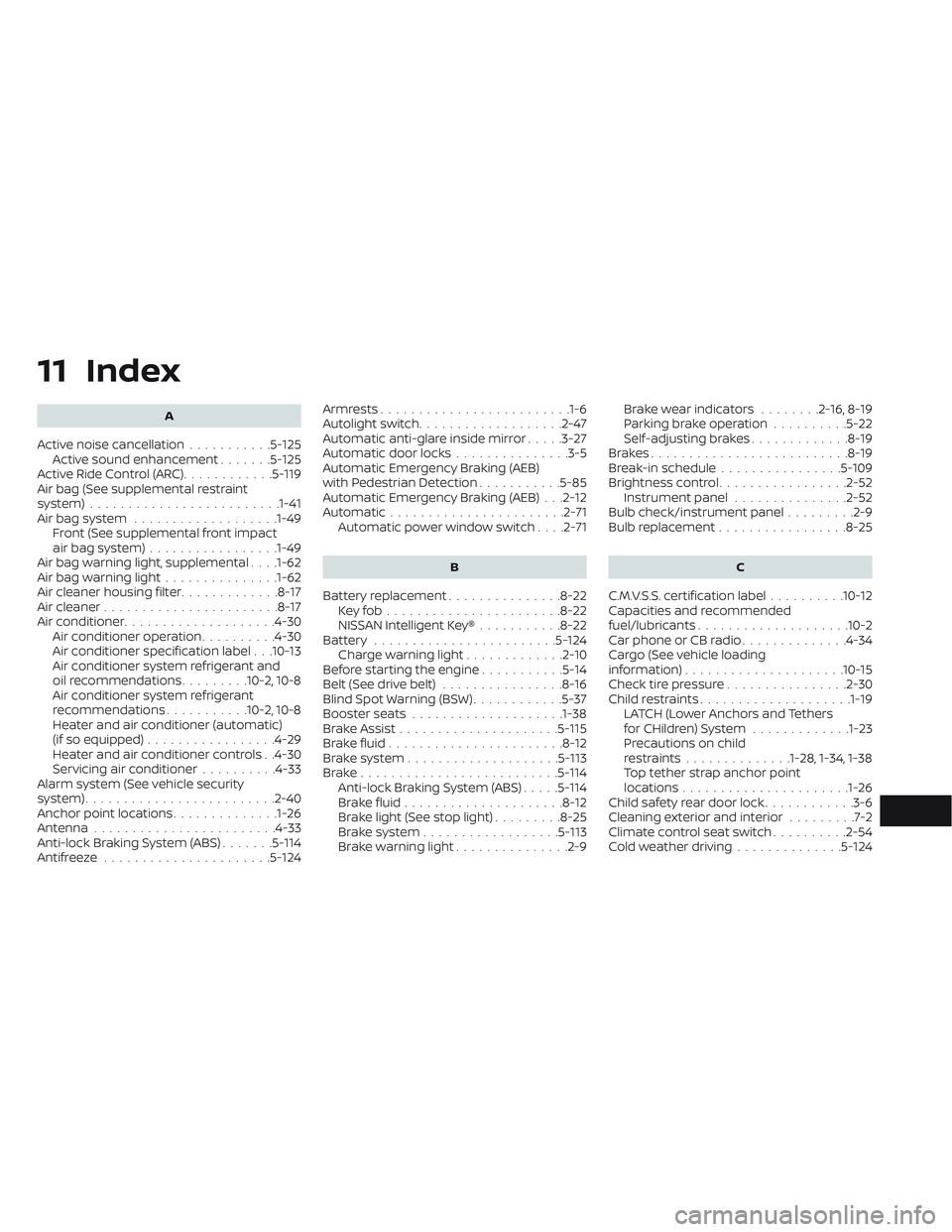
11 Index
A
Activenoisecancellation...........5-125Active sound enhancement .......5-125
ActiveRideControl(ARC)............5 -119
Air bag (See supplemental restraint
system) ........................ .1-41
Air bag system ...................1-49
Front (See supplemental front impact
air bag system) .................1-49
Air bag warning light, supplemental . . . .1-62
Airbagwarninglight.............. .1-62
Air cleaner housing filter .............8-17
Air cleaner .......................8-17
Air conditioner ....................4-30
Air conditioner operation ..........4-30
Air conditioner specification label . . .10-13
Air conditioner system refrigerant and
oil recommendations .........10-2,10-8
Air conditioner system refrigerant
recommendations ...........10-2,10-8
Heater and air conditioner (automatic)
(if so equipped) .................4-29
Heater and air conditioner controls . .4-30
Servicing air conditioner ..........4-33
Alarm system (See vehicle security
system) .........................2-40
Anchor point locations ..............1-26
Antenna ........................4-33
Anti-lock Braking System (ABS) .......5-114
Antifreeze ......................5-124 Armrests........................
.1-6
Autolightswitch...................2-47
Automatic anti-glare inside mirror .....3-27
Automatic door locks ...............3-5
Automatic Emergency Braking (AEB)
with Pedestrian Detection ...........5-85
Automatic Emergency Braking (AEB) . . .2-12
Automatic.......................2-71 Automaticpowerwindowswitch....2-71
B
Battery replacement ...............8-22
Keyfob.......................8-22
NISSAN Intelligent Key® ...........8-22
Battery ........................5-124 Charge warning light .............2-10
Before starting the engine ...........5-14
Belt(Seedrivebelt) ................8-16
Blind Spot Warning (BSW) ............5-37
Booster seats ................... .1-38
Brake Assist .....................5 -115
Brakefluid.......................8-12
Brake system ....................5 -113
Brake..........................5 -114
Anti-lock Braking System (ABS) .....5-114
Brakefluid.....................8-12
Brakelight(Seestoplight).........8-25
Brake system ..................5 -113
Brakewarninglight...............2-9 Brakewearindicators ........2-16,8-19
Parking brake operation
..........5-22
Self-adjustingbrakes.............8-19
Brakes..........................8-19
Break-in schedule ................5-109
Brightness control .................2-52
Instrument panel ...............2-52
Bulb check/instrument panel .........2-9
Bulb replacement .................8-25
C
C.M.V.S.S. certification label ..........10-12
Capacities and recommended
fuel/lubricants....................10-2
Car phone or CB radio ..............4-34
Cargo (See vehicle loading
information).....................10-15
Check tire pressure ................2-30
Childrestraints................... .1-19
LATCH (Lower Anchors and Tethers
forCHildren)System .............1-23
Precautions on child
restraints..............1-28, 1-34, 1-38
Top tether strap anchor point
locations..................... .1-26
Child safety rear door lock ............3-6
Cleaningexteriorandinterior .........7-2
Climatecontrolseatswitch..........2-54
Cold weather driving ..............5-124
Page 480 of 494
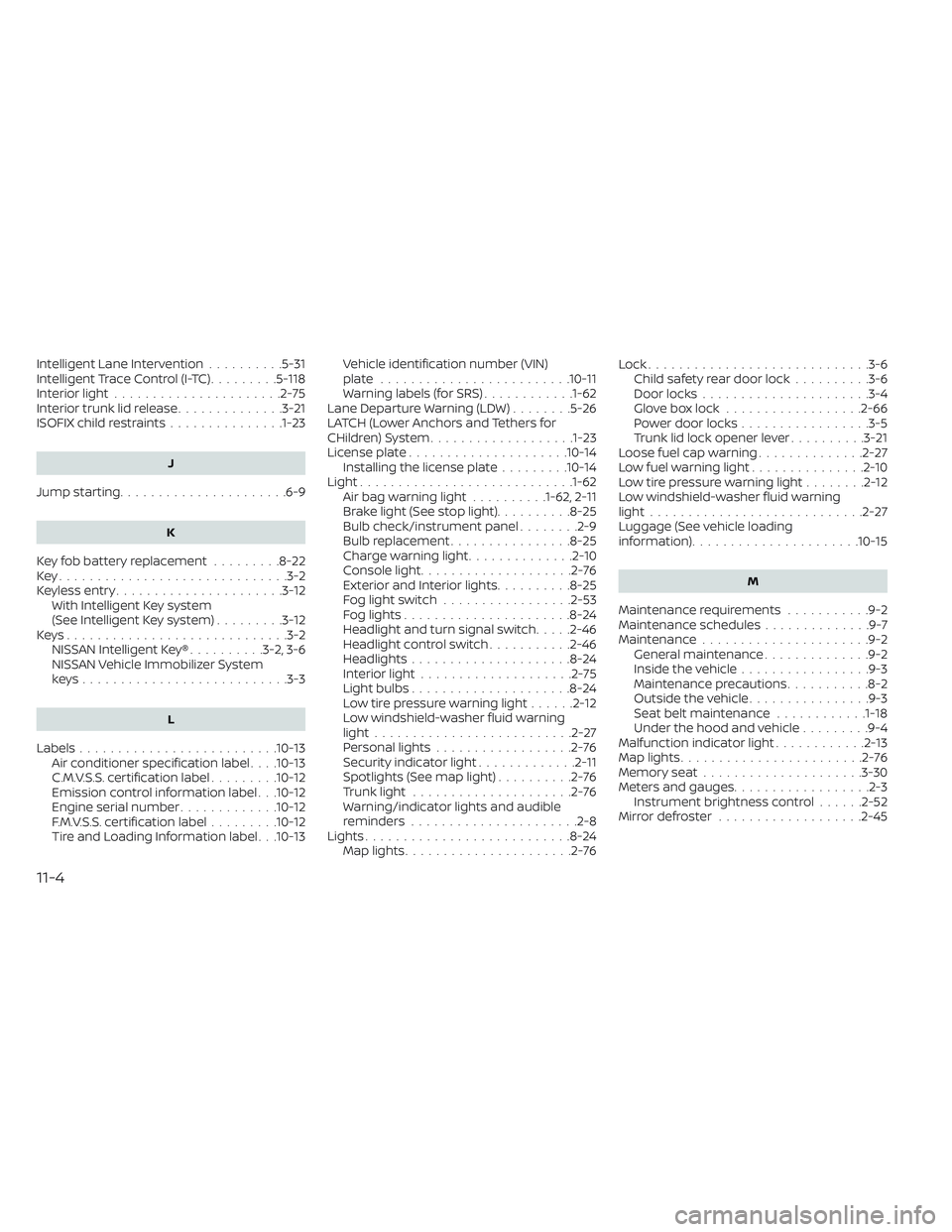
Intelligent Lane Intervention..........5-31
Intelligent Trace Control (I-TC) .........5-118
Interiorlight ......................2-75
Interiortrunklidrelease..............3-21
ISOFIX child restraints ...............1-23
J
Jumpstarting......................6-9
K
Key fob battery replacement .........8-22
Key..............................3-2
Keylessentry......................3-12 With Intelligent Key system
(See Intelligent Key system) .........3-12
Keys.............................3-2 NISSAN Intelligent Key® ..........3-2,3-6
NISSAN Vehicle Immobilizer System
keys...........................3-3
L
Labels ..........................10-13
Air conditioner specification label . . . .10-13
C.M.V.S.S. certification label .........10-12
Emission control information label . . .10-12
Engine serial number .............10-12
F.M.V.S.S. certification label .........10-12
Tire and Loading Information label . . .10-13 Vehicle identification number (VIN)
plate .........................10-11
Warning labels (for SRS)
............1-62
Lane Departure Warning (LDW) ........5-26
LATCH (Lower Anchors and Tethers for
CHildren)System.................. .1-23
License plate .....................10-14
Installing the license plate .........10-14
Light........................... .1-62
Airbagwarninglight ..........1-62, 2-11
Brakelight(Seestoplight)..........8-25
Bulb check/instrument panel ........2-9
Bulb replacement ................8-25
Charge warning light ..............2-10
Console light ....................2-76
ExteriorandInteriorlights..........8-25
Foglightswitch .................2-53
Foglights......................8-24
Headlight and turn signal switch .....2-46
Headlightcontrolswitch...........2-46
Headlights.....................8-24
Interiorlight ....................2-75
Lightbulbs.....................8-24
Low tire pressure warning light ......2-12
Low windshield-washer fluid warning
light..........................2-27
Personal lights ..................2-76
Security indicator light .............2-11
Spotlights(Seemaplight)..........2-76
Trunklight .....................2-76
Warning/indicator lights and audible
reminders ......................2-8
Lights...........................8-24 Maplights......................2-76 Lock............................
.3-6
Child safety rear door lock ..........3-6
Door locks ..................... .3-4
Gloveboxlock ..................2-66
Power door locks .................3-5
Trunk lid lock opener lever ..........3-21
Loose fuel cap warning ..............2-27
Lowfuelwarninglight...............2-10
Low tire pressure warning light ........2-12
Low windshield-washer fluid warning
light........................... .2-27
Luggage (See vehicle loading
information)......................10-15
M
Maintenance requirements ...........9-2
Maintenance schedules ..............9-7
Maintenance ......................9-2
General maintenance ..............9-2
Insidethevehicle.................9-3
Maintenance precautions ...........8-2
Outsidethevehicle................9-3
Seat belt maintenance ............1-18
Under the hood and vehicle .........9-4
Malfunctionindicatorlight........... .2-13
Maplights........................2-76
Memory seat .....................3-30
Meters and gauges ..................2-3
Instrument brightness control ......2-52
Mirrordefroster ...................2-45
11-4